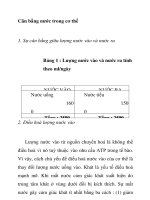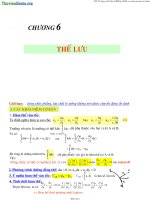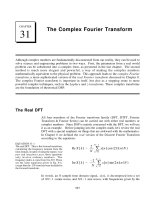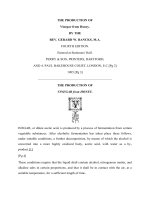The honey connoisseur
Bạn đang xem bản rút gọn của tài liệu. Xem và tải ngay bản đầy đủ của tài liệu tại đây (10.61 MB, 875 trang )
The
HONEY
CONNOISSEUR
Selecting, Tasting, and
Pairing Honey, With a
Guide to More than 30
Varietals
C. Marina Marchese &
Kim Flottum
Illustrations by Elara Tanguy
DEDICATION
FROM KIM…
Marina certainly is the inspiration for
this work. We have worked together on
projects in the past and this was the next
step for each of us. Her focus is on the
magic of how and why honey comes to
be. Mine shows where and when honey
is born. Each of us following a passion
has produced what you now read.
Passions, though, are fueled by many
fires. My other passion, my best friend
and my greatest source of support and
balance, Kathy, made this book, and
everything, possible. Thanks Kath.
FROM MARINA…
Without Kim, this book would not be
complete.
Without Vic, there would not be time to
write it.
Without Becky, no one would ever read
it.
Without the bees, there would be no
honey.
Without beekeepers, there would be no
passion.
Without honey lovers, there would be no
reason.
A heart-full of thanks to all those who
came on the journey and have embraced
this sweet work.
CONTENTS
CHAPTER 1:
La Dolce Vita
CHAPTER 2:
Terroir: A Portrait of the
Land
CHAPTER 3:
The Honey Plants
CHAPTER 4:
The Not-So-Sweet Side of
Honey
CHAPTER 5:
Tasting Honey
CHAPTER 6:
Pairing Honey with Cheese
and Food
Glossary
Index
References
CHAPTER 1
LA DOLCE VITA
In the Valley of the Kings on
the West Bank at Luxor there
is a tomb named KV 62 that
was cut during Egypt’s
eighteenth dynasty. It belongs
to the Egyptian pharaoh
Tutankhamen. Discovered in
1922 by Howard Carter, it is
considered one of the most
significant archaeological
discoveries of the twentieth
century. As was the tradition
in ancient Egypt, the pharaoh
was buried with a cache of
artifacts, including furniture,
garments, and food. Among
these articles were clay vessels
filled with olive oil and wine.
he vessels were inscribed with
detailed notes naming the type of
wine, the producer, the
geographic region in which it
was produced, and the date when the jar
was sealed. Nearby were two more
vessels described by Carter as drab
pottery with double handles, bound with
rush and secured with clay seals. The
shoulders of these vessels carried the
identification of the contents, written
from right to left, in black hieratic script,
depicting the word for honey bee. When
the clay seals were removed, the insides
of the jars revealed honey, completely
preserved, still almost liquid, and
retaining its original sweet aroma. These
offerings of honey, olive oil, and wine
T
were placed in King Tut’s tomb
alongside his body because it was
believed that he would need these items
in his afterlife. More than three thousand
years later, the olive oil and wine had
spoiled, but the honey remained intact
and edible.
Bees and honey played an important
part in the everyday life of the
Egyptians. They were the first nomadic
beekeepers, floating their hives up and
down the Nile following the seasonal
blooms. Their main sources for nectar
were orange, clover, and cotton. Honey
was removed from the hives by smoking
out the bees, then crushing the comb and
straining the honey into clay jars. It was
used as a culinary sweetener, as well as
for mead and medicine. Ancient medical
texts written on papyrus describe honey
as being used for ointments and touting
its therapeutic effects on wounds. The
walls of tombs were rich in bee imagery
depicting scenes of beekeeping and
honey production. Cleopatra, the last
ruling pharaoh, celebrated for her
beauty, was said to be indebted to honey
inside and out. After her ritual of bathing
in milk and honey she indulged in her
favorite snack, a sweet honey nut truffle
called dulcis coccora.
Honey, like wine and olive oil, was
considered a luxury by the Egyptians and
was stored in clay amphorae or wooden
flat-bottom vessels. The chards
recovered from Tutankhamen’s tomb
revealed that each amphora was
carefully labeled with information
including the honey’s source or
provenance, the date and location of its
production, and the name of the person
who sealed the jar. The origin and
quality of agricultural products
obviously played an important role in
ancient societies. The title “sealer of the
honey” was given to those respected
people who oversaw the act of sealing
the honey-filled vessels, ensuring quality
control. The descriptions of these
practices are the earliest references to
terroir and the high value placed on
agricultural commodities.
The Science and Art of
Making Honey
Honey is made by honey bees from the
nectar of flowers. Inside every beehive
is a honey-making factory buzzing with
activity where nature’s virtuose are
transforming the floral nectar into the
sweetest elixir on the planet. A worker
honey bee will make just teaspoon of
this culinary masterpiece in her short
life. Hundreds of varieties of honey are
harvested here in the United States, and
thousands around the world. Many are
limited harvests, produced seasonally
and remaining local to their region. The
recipe never changes, only the flower,
the nectar, the season, and the region in
which it’s collected. It’s these factors
that make every jar of honey unique in
color, aroma, and flavor.
Honey is exclusively the creation of
the female worker honey bees, who are
also responsible for almost all other
hive duties, including brood rearing,
collecting nectar and pollen, cleaning
house, building beeswax comb,
defending the hive, and attending to the
queen. The queen will outlive all of her
daughters and sons because of her
special diet of royal jelly, but she does
not directly contribute to honey
production in any way. The colony is
also made up of a smaller, seasonal
population of male bees called drones,
whose main purpose is to mate with a
queen from another colony, but they also
serve other purposes. When drones are
present the hive’s population is in
balance. Drones act as heat sinks aiding
the colony by giving off heat from their
warm bodies on cool spring and summer
evenings. They also produce a series of
pheromones that help motivate workers
to collect both nectar and pollen.
Worker bees begin foraging for water,
pollen, nectar, and propolis (a resinous
material used to repair and maintain the
hive) when they’re about twenty-one
days old. The honey-making process
begins in a sunny field of blooming
flowers, where a worker bee chooses to
visit the most attractive flowers with the
sweetest-smelling nectar. She hovers
over its petals, then gracefully lands,
probing the flower to locate the nectar,
and begins sipping up the nectar with her
long, tube-like tongue called a
proboscis. When she is satisfied, she
seeks out more flowers of the same
species until her nectar-carrying storage
container, called a honey sac, is full.
Then she carries her bounty back to her
hive. A worker bee’s tiny body is
capable of carrying more than her own
weight in nectar. While the bee is on the
way home, the nectar is mixed inside the
honey sac with an enzyme called
invertase, beginning the transformation
into honey. Once back at the hive she
transfers her load to her sisters to
continue the honey-making process.
A worker bee inside the hive accepts
the nectar from the foraging bee and
manipulates it with her mouthparts for a
time, exposing it to the hive’s dry air,
and adding even more enzymes. She then
hangs it on the top of one of the
hexagonal beeswax cells that make up
the entire honey bee nest. After the
nectar is placed in a cell, the bees set to
work reducing its water content by
fanning their wings to produce a
continuous breeze, a process aided by
the high temperature in the hive. This
action dries and ripens the nectar,
which, when it is dehydrated to about
17–18 percent moisture, becomes thick,
sweet, pure honey. The bees consolidate
the resulting honey from many partially
filled cells to fewer cells that are full of
honey. They then cover or cap each
honey-filled cell with beeswax to keep it
safe and fresh. Honey remains pristine
inside these cells until it is needed by
the bees to sustain the colony. Given
sufficient space inside a hive and
compatible weather conditions, a
healthy, strong colony of honey bees will
continually produce and store honey as
long as nectar is available and they are
able to collect it. The bees need some of
this bounty for their daily food, and seek
to store enough to see them through the
winter. Any excess honey is what the
beekeeper will harvest.
Scout Bees
cout bees are specially
designated worker bees that
seek out the flowers by
returning to familiar
locations and searching for
attractive scents for other foraging
honey bees. Once a location is found
that has a lot of flowers, each with
nectar and high sugar content, the
S









